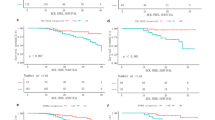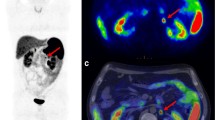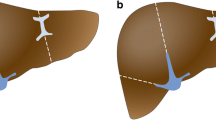Abstract
Objectives
We aimed to evaluate the diagnostic ability for the prediction of histologic grades and prognostic values on recurrence and death of pretreatment 2-[18F]FDG PET/CT in patients with resectable thymic epithelial tumours (TETs).
Methods
One hundred and fourteen patients with TETs who underwent pretreatment 2-[18F]FDG PET/CT between 2012 and 2018 were retrospectively evaluated. TETs were classified into three histologic subtypes: low-risk thymoma (LRT, WHO classification A/AB/B1), high-risk thymoma (HRT, B2/B3), and thymic carcinoma (TC). Area under the receiver operating characteristics curve (AUC) was used to assess the diagnostic performance of PET/CT variables (maximum standardised uptake value [SUVmax], metabolic tumour volume [MTV], total lesion glycolysis [TLG], maximum diameter). Cox proportional hazards models were built using PET/CT and clinical variables.
Results
The tumours included 52 LRT, 33 HRT, and 29 TC. SUVmax showed good diagnostic ability for differentiating HRT/TC from LRT (AUC 0.84, 95% confidence interval [CI] 0.76 − 0.92) and excellent ability for differentiating TC from LRT/HRT (AUC 0.94, 95% CI 0.90 − 0.98), with significantly higher values than MTV, TLG, and maximum diameter. With an optimal cut-off value of 6.4, the sensitivity, specificity, and accuracy for differentiating TC from LRT/HRT were 69%, 96%, and 89%, respectively. In the multivariable Cox proportional hazards analyses for freedom-from-recurrence, SUVmax was an independent prognostic factor (p < 0.001), whereas MTV and TLG were not. SUVmax was a significant predictor for overall survival in conjunction with clinical stage and resection margin.
Conclusion
SUVmax showed excellent diagnostic performance for prediction of TC and significant prognostic value in terms of recurrence and survival.
Key Points
• Maximum standardised uptake value (SUVmax) shows excellent performance in the differentiation of thymic carcinoma from low- and high-risk thymoma.
• SUVmax is an independent prognostic factor for freedom-from-recurrence in the multivariable Cox proportional hazard model and a significant predictor for overall survival.
• 2-[ 18 F]FDG PET/CT can provide a useful diagnostic and prognostic imaging biomarker in conjunction with histologic classification and stage and help choose appropriate management for thymic epithelial tumours.





Similar content being viewed by others
Abbreviations
- 2-[18F]FDG:
-
2-Deoxy-2-[18F]fluoro-D-glucose
- ACR:
-
American College of Radiology
- AIC:
-
Akaike information criterion
- ANOVA:
-
One-way analysis of variance
- AUC:
-
Area under the curve
- CI:
-
Confidence interval
- C-index:
-
Concordance index
- CT:
-
Computed tomography
- FFR:
-
Freedom-from-recurrence
- HRT:
-
High-risk thymoma
- IQR:
-
Interquartile range
- ITMIG:
-
International Thymic Malignancy Interest Group
- LRT:
-
Low-risk thymoma
- MRI:
-
Magnetic resonance imaging
- MTV:
-
Metabolic tumour volume
- OS:
-
Overall survival
- PET:
-
Positron emission tomography
- ROC:
-
Receiver operating characteristics
- SUVmax:
-
Maximum standardised uptake value
- TC:
-
Thymic carcinoma
- TET:
-
Thymic epithelial tumour
- TLG:
-
Total lesion glycolysis
- WHO:
-
World Health Organization
References
Lee HS, Oh JS, Park YS, Jang SJ, Choi IS, Ryu JS (2016) Differentiating the grades of thymic epithelial tumor malignancy using textural features of intratumoral heterogeneity via (18)F-FDG PET/CT. Ann Nucl Med 30:309–319
Travis WD, Brambilla E, Müller-Hermelink HK, Harris CC (2004) Pathology and genetics of tumours of the lung, pleura, thymus and heart, 3rd edn. IARC Press, Lyon
Okumura M, Ohta M, Tateyama H et al (2002) The World Health Organization histologic classification system reflects the oncologic behavior of thymoma: a clinical study of 273 patients. Cancer 94:624–632
Marchevsky AM, Gupta R, McKenna RJ et al (2008) Evidence-based pathology and the pathologic evaluation of thymomas: the World Health Organization classification can be simplified into only 3 categories other than thymic carcinoma. Cancer 112:2780–2788
Yun JK, Lee GD, Kim HR et al (2019) A nomogram for predicting recurrence after complete resection for thymic epithelial tumors based on the TNM classification: A multi-institutional retrospective analysis. J Surg Oncol 119:1161–1169
Falkson CB, Bezjak A, Darling G et al (2009) The management of thymoma: a systematic review and practice guideline. J Thorac Oncol 4:911–919
Lucchi M, Melfi F, Dini P et al (2006) Neoadjuvant chemotherapy for stage III and IVA thymomas: a single-institution experience with a long follow-up. J Thorac Oncol 1:308–313
Detterbeck FC, Moran C, Huang J et al (2011) Which way is up? Policies and procedures for surgeons and pathologists regarding resection specimens of thymic malignancy. J Thorac Oncol 6:S1730-1738
Jeong YJ, Lee KS, Kim J, Shim YM, Han J, Kwon OJ (2004) Does CT of thymic epithelial tumors enable us to differentiate histologic subtypes and predict prognosis? AJR Am J Roentgenol 183:283–289
Tomiyama N, Johkoh T, Mihara N et al (2002) Using the World Health Organization Classification of thymic epithelial neoplasms to describe CT findings. AJR Am J Roentgenol 179:881–886
Sadohara J, Fujimoto K, Müller NL et al (2006) Thymic epithelial tumors: comparison of CT and MR imaging findings of low-risk thymomas, high-risk thymomas, and thymic carcinomas. Eur J Radiol 60:70–79
Kaira K, Endo M, Abe M et al (2010) Biologic correlation of 2-[18F]-fluoro-2-deoxy-D-glucose uptake on positron emission tomography in thymic epithelial tumors. J Clin Oncol 28:3746–3753
Treglia G, Sadeghi R, Giovanella L, Cafarotti S, Filosso P, Lococo F (2014) Is (18)F-FDG PET useful in predicting the WHO grade of malignancy in thymic epithelial tumors? A meta-analysis. Lung Cancer 86:5–13
Nakajo M, Jinguji M, Shinaji T et al (2018) Texture analysis of (18)F-FDG PET/CT for grading thymic epithelial tumours: usefulness of combining SUV and texture parameters. Br J Radiol 91:20170546
Sung YM, Lee KS, Kim BT, Choi JY, Shim YM, Yi CA (2006) 18F-FDG PET/CT of thymic epithelial tumors: usefulness for distinguishing and staging tumor subgroups. J Nucl Med 47:1628–1634
Hamaji M, Koyasu S, Omasa M et al (2021) Are volume-dependent parameters in positron emission tomography predictive of postoperative recurrence after resection in patients with thymic carcinoma? Surg Today 51:322–326
Seki N, Sakamoto S, Karube Y, Oyaizu T, Ishihama H, Chida M (2014) 18F-fluorodeoxyglucose positron emission tomography for evaluation of thymic epithelial tumors: utility for World Health Organization classification and predicting recurrence-free survival. Ann Nucl Med 28:257–262
Morgan DJ, Bray KM (1994) Lean body mass as a predictor of drug dosage. Implications for drug therapy. Clin Pharmacokinet 26:292–307
DeLong ER, DeLong DM, Clarke-Pearson DL (1988) Comparing the areas under two or more correlated receiver operating characteristic curves: a nonparametric approach. Biometrics 44:837–845
Huang J, Detterbeck FC, Wang Z, Loehrer PJ Sr (2010) Standard outcome measures for thymic malignancies. J Thorac Oncol 5:2017–2023
Kang L, Chen W, Petrick NA, Gallas BD (2015) Comparing two correlated C indices with right-censored survival outcome: a one-shot nonparametric approach. Stat Med 34:685–703
Kaira K, Murakami H, Miura S et al (2011) 18F-FDG uptake on PET helps predict outcome and response after treatment in unresectable thymic epithelial tumors. Ann Nucl Med 25:247–253
Thomas A, Mena E, Kurdziel K et al (2013) 18F-fluorodeoxyglucose positron emission tomography in the management of patients with thymic epithelial tumors. Clin Cancer Res 19:1487–1493
Moon SH, Kim HS, Cho YS et al (2016) Value of volume-based early metabolic response in patients with unresectable thymic epithelial tumor. Lung Cancer 100:24–29
Han S, Kim H, Kim YJ, Suh CH, Woo S (2018) Prognostic value of volume-based metabolic parameters of (18)F-FDG PET/CT in uterine cervical cancer: a systematic review and meta-analysis. AJR Am J Roentgenol 211:1112–1121
Pak K, Cheon GJ, Nam HY et al (2014) Prognostic value of metabolic tumor volume and total lesion glycolysis in head and neck cancer: a systematic review and meta-analysis. J Nucl Med 55:884–890
Im HJ, Pak K, Cheon GJ et al (2015) Prognostic value of volumetric parameters of (18)F-FDG PET in non-small-cell lung cancer: a meta-analysis. Eur J Nucl Med Mol Imaging 42:241–251
Lee J, Cho YS, Kim J, Shim YM, Lee KH, Choi JY (2021) Prognostic significance of metabolic parameters by (18)F-FDG PET/CT in thymic epithelial tumors. Cancers (Basel) 13:712
Hayden JA, van der Windt DA, Cartwright JL, Côté P, Bombardier C (2013) Assessing bias in studies of prognostic factors. Ann Intern Med 158:280–286
In J, Lee DK (2018) Survival analysis: part I - analysis of time-to-event. Korean J Anesthesiol 71:182–191
Abraira V, Muriel A, Emparanza JI et al (2013) Reporting quality of survival analyses in medical journals still needs improvement. A minimal requirements proposal. J Clin Epidemiol 66:1340-1346.e1345
Matsumoto K, Ashizawa K, Tagawa T, Nagayasu T (2007) Chest wall implantation of thymic cancer after computed tomography-guided core needle biopsy. Eur J Cardiothorac Surg 32:171–173
den Bakker MA, Roden AC, Marx A, Marino M (2014) Histologic classification of thymoma: a practical guide for routine cases. J Thorac Oncol 9:S125-130
Verghese ET, den Bakker MA, Campbell A et al (2008) Interobserver variation in the classification of thymic tumours–a multicentre study using the WHO classification system. Histopathology 53:218–223
Tseng YC, Tseng YH, Kao HL et al (2017) Long term oncological outcome of thymoma and thymic carcinoma - an analysis of 235 cases from a single institution. PLoS One 12:e0179527
Steyerberg EW, Harrell FE Jr (2016) Prediction models need appropriate internal, internal-external, and external validation. J Clin Epidemiol 69:245–247
Liu H, Gu Z, Qiu B et al (2020) A recurrence predictive model for thymic tumors and its implication for postoperative management: a Chinese Alliance for Research in Thymomas Database Study. J Thorac Oncol 15:448–456
Wang Y, Xu L, Du T, Gao Y, Wu Z, Luo D (2018) A nomogram predicting recurrence and guiding adjuvant radiation for thymic carcinoma after resection. Ann Thorac Surg 106:257–263
Funding
This work was supported by the National Research Foundation of Korea (NRF) grant funded by the Korean government (Ministry of Science and ICT; No. NRF-2020M2D9A1094074) and by a grant from the Korea Health Technology R&D Project through the Korea Health Industry Development Institute (KHIDI), funded by the Ministry of Health & Welfare, Republic of Korea (HI18C2383).
Author information
Authors and Affiliations
Corresponding author
Ethics declarations
Guarantor
The scientific guarantor of this publication is Y.Kim.
Conflict of interest
The authors of this manuscript declare no relationships with any companies whose products or services may be related to the subject matter of the article.
Statistics and biometry
Three of the authors (S.Han, Y.Kim, and J.S.Oh) have significant statistical expertise.
Informed consent
Written informed consent was waived by the Institutional Review Board.
Ethical approval
Institutional Review Board approval was obtained.
Study subjects or cohorts overlap
Some study subjects or cohorts have been previously reported in: Four of 114 study cohorts have been previously reported in the original scientific article conducted by coauthors of this study (Lee and Oh et al. Ann Nucl Med (2016) 30:309–319; https://doi.org/10.1007/s12149-016-1062-2).
Methodology
• Retrospective
• Diagnostic or prognostic study
• Performed at one institution
Additional information
Publisher’s note
Springer Nature remains neutral with regard to jurisdictional claims in published maps and institutional affiliations.
Supplementary Information
Below is the link to the electronic supplementary material.
Rights and permissions
About this article
Cite this article
Han, S., Kim, Yi., Oh, J.S. et al. Diagnostic and prognostic values of 2-[18F]FDG PET/CT in resectable thymic epithelial tumour. Eur Radiol 32, 1173–1183 (2022). https://doi.org/10.1007/s00330-021-08230-z
Received:
Revised:
Accepted:
Published:
Issue Date:
DOI: https://doi.org/10.1007/s00330-021-08230-z




